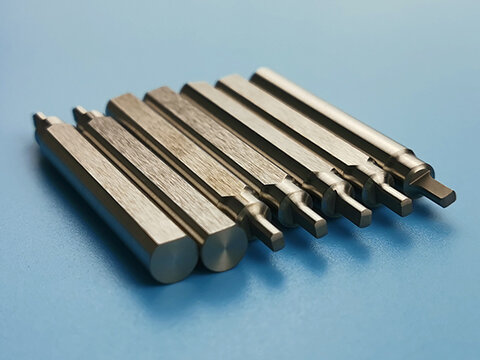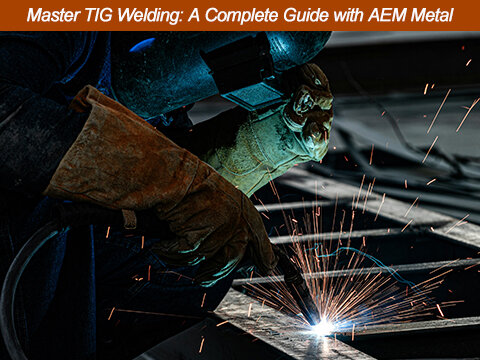Imagine crafting a precise, flawless weld, where every atom aligns perfectly. This is the power of TIG welding, a technique that demands precision, skill, and the right tools.
At AEM Metal, we are committed to providing the highest quality tungsten electrodes essential for achieving exceptional TIG welding results. As a leading supplier in the industry, we understand the critical role these electrodes play in ensuring the success of your projects.
Understanding TIG Welding
TIG welding, or tungsten inert gas welding, is a type of arc welding that uses a non-consumable tungsten electrode to create an electric arc between the electrode and the workpiece. A shielding gas, typically argon or helium, is used to protect the weld area from atmospheric contaminants.
The key components involved in TIG welding include the tungsten electrode, workpiece, shielding gas, power source, and filler metal. TIG welding offers several advantages over other welding methods, such as high-quality welds, versatility, control, the ability to weld thin materials, and a clean environment.
Advantages of TIG welding:
-
High-quality welds: TIG welding produces clean, precise welds with excellent penetration and appearance.
-
Versatility: It can be used to weld a wide range of metals, including stainless steel, aluminum, titanium, and copper.
-
Control: TIG welding offers precise control over the welding process, allowing for intricate and detailed work.
-
Thin materials: It can be used to weld thin materials with minimal distortion.
-
Clean environment: The shielding gas protects the weld from contamination, resulting in a cleaner and more corrosion-resistant joint.
The Importance of Tungsten Electrodes
In TIG welding, the tungsten electrode is the heart of the process. It generates the electric arc that melts the workpiece and filler metal, creating a strong and durable weld. The choice of tungsten electrode is critical for achieving optimal weld quality and efficiency.
There are different types of tungsten electrodes, including pure tungsten, thoriated tungsten, and ceriated tungsten, each with its own specific properties and uses. The choice of electrode depends on factors such as the metal being welded, the welding current, and the desired weld quality.
Types of tungsten electrodes:
-
Pure tungsten: This is the most basic type of tungsten electrode, suitable for general-purpose welding applications. It offers good arc stability and is relatively inexpensive.
-
Thoriated tungsten: Contains 2% thoria, which improves arc starting and reduces electrode wear. It is ideal for welding thin materials and AC welding.
-
Ceriated tungsten: Contains 2% cerium oxide, providing similar benefits to thoriated tungsten but with a lower radioactive content. It is a popular choice for many welding applications.
Factors affecting electrode choice:
The type of metal being welded, the amperage used for welding, and the desired level of weld quality are all factors that influence the choice of tungsten electrode. For example, stainless steel often requires a thoriated or ceriated electrode, while aluminum may benefit from a pure tungsten electrode. Higher amperages may require a thicker electrode with a higher thoria or cerium content. And for critical applications, a high-quality electrode with good arc stability and durability is essential.
AEM Metal: Your Trusted Tungsten Electrode Supplier

AEM Metal is a top supplier of high-quality tungsten electrodes for TIG welding. With years of experience in the industry, we offer a wide range of products, including pure tungsten, thoriated tungsten, and ceriated tungsten electrodes. We also provide custom solutions to meet your specific needs.
Our tungsten electrodes are known for their reliability, durability, and competitive pricing. Our team is dedicated to providing excellent customer service and is always available to answer your questions and offer expert advice.
When you choose AEM Metal, you can be confident in the quality of our products and the reliability of our service.
TIG Welding vs. Other Welding Processes
TIG welding, also known as tungsten inert gas welding, offers several distinct advantages over other welding processes. Here's a comparison:
TIG Welding vs. MIG Welding
-
Electrode: TIG uses a non-consumable tungsten electrode, while MIG uses a consumable wire electrode.
-
Shielding gas: Both TIG and MIG use a shielding gas to protect the weld from atmospheric contaminants, but TIG often uses argon or helium, while MIG may use a mixture of gases like argon and carbon dioxide.
-
Control: TIG offers more precise control over the welding process, making it ideal for detailed work and thin materials.
-
Quality: TIG generally produces higher-quality welds with better penetration and appearance.
-
Speed: MIG welding is often faster than TIG welding, especially for thicker materials.
TIG Welding vs. Stick Welding
-
Electrode: Both TIG and stick welding use a non-consumable electrode, but stick welding uses a coated electrode.
-
Shielding gas: TIG uses a shielding gas, while stick welding relies on the coating on the electrode for protection.
-
Portability: Stick welding is more portable than TIG welding due to the simplicity of its equipment.
-
Cost: Stick welding is generally less expensive than TIG welding due to the lower cost of electrodes and equipment.
-
Quality: TIG welding typically produces higher-quality welds with better appearance and fewer defects.
TIG Welding vs. Plasma Arc Welding
-
Electrode: Both TIG and plasma arc welding use a non-consumable electrode, but plasma arc welding uses a constricted arc that is hotter and more concentrated.
-
Speed: Plasma arc welding is generally faster than TIG welding due to the higher heat input.
-
Cutting: Plasma arc welding can also be used for cutting materials, while TIG welding is primarily used for joining.
-
Cost: Plasma arc welding equipment is typically more expensive than TIG welding equipment.
In conclusion, TIG welding is a versatile and high-quality welding process that is well-suited for a wide range of applications, especially those requiring precise control, clean welds, and the ability to weld thin materials. While other welding processes may be more suitable for certain tasks, TIG welding remains a valuable tool for many industries.
TIG Welding Applications in Different Industries
TIG welding, known for its precision and versatility, has found widespread application across various industries. Here's a breakdown of its use in some key sectors:
Aerospace and Aviation
From crafting aircraft fuselages to constructing spacecraft components, TIG welding's ability to create clean, strong welds is indispensable. Its precision ensures the structural integrity of these critical parts.
Automotive Industry
The automotive industry relies on TIG welding for a variety of components, including exhaust systems, chassis parts, and body panels. Its clean welds contribute to the overall durability and performance of vehicles.
Manufacturing and Fabrication
TIG welding is a go-to technique for fabricating stainless steel structures, aluminum components, and pressure vessels. Its ability to create corrosion-resistant and high-quality welds is invaluable in these sectors.
Art and Sculpture
Beyond industrial applications, TIG welding has found a niche in the world of art. Sculptors and jewelers employ this technique to create intricate and durable pieces.
Other Industries
From medical equipment to electronics and nuclear power, TIG welding's versatility extends to a wide range of industries, ensuring precision and safety in critical applications.\
Conclusion
TIG welding is a precision welding process that demands the use of high-quality tungsten electrodes. AEM Metal is a trusted supplier of these essential components, offering a wide range of options to suit various welding applications.
By understanding the fundamentals of TIG welding and selecting the right tungsten electrodes, you can achieve superior weld quality, enhance efficiency, and ensure the longevity of your projects. Our team of experts is dedicated to providing exceptional customer service and supporting you throughout the welding process.
Are you ready to elevate your TIG welding performance? Contact AEM Metal today to discuss your specific needs and discover how our tungsten electrodes can benefit your business.












